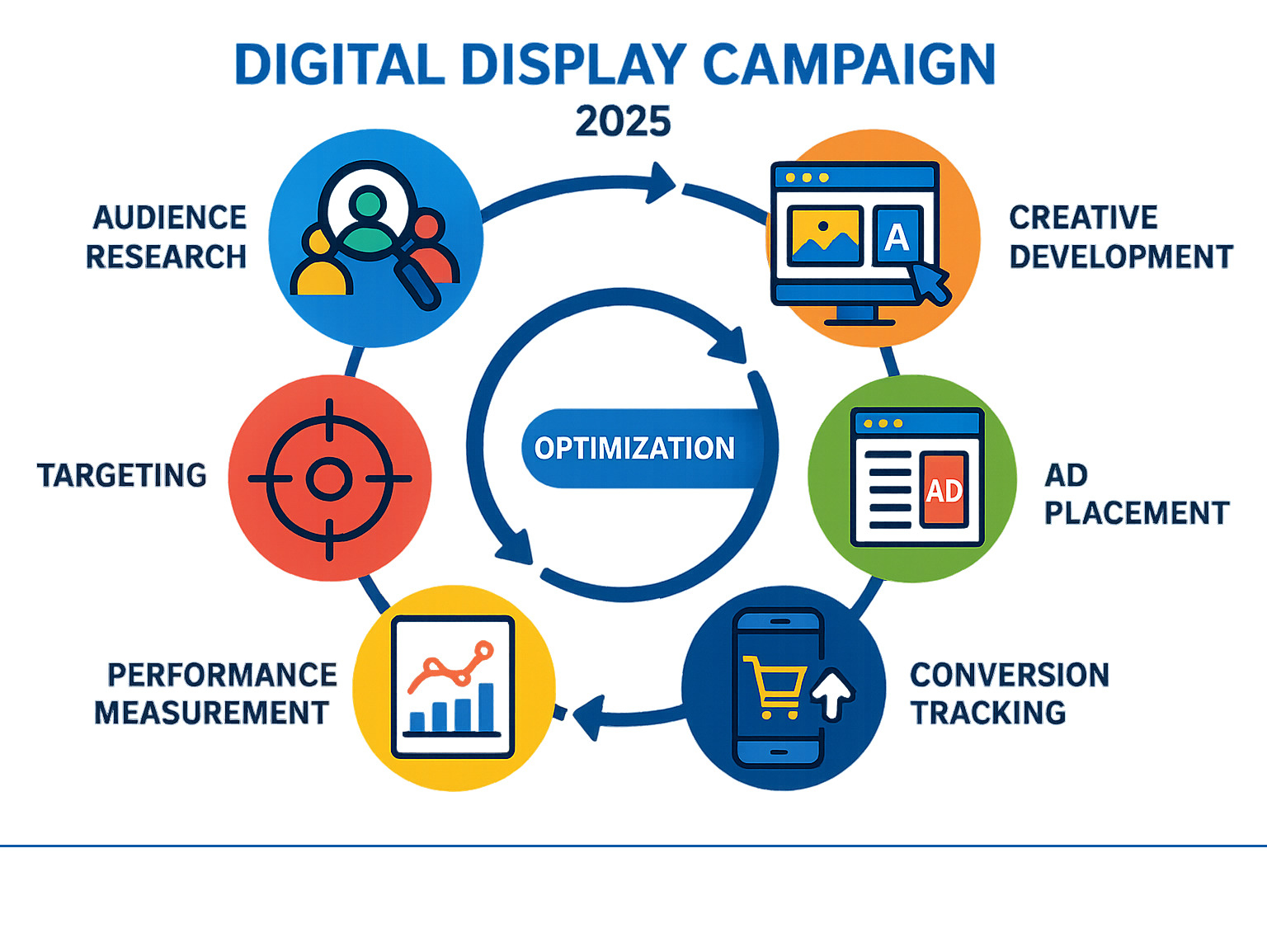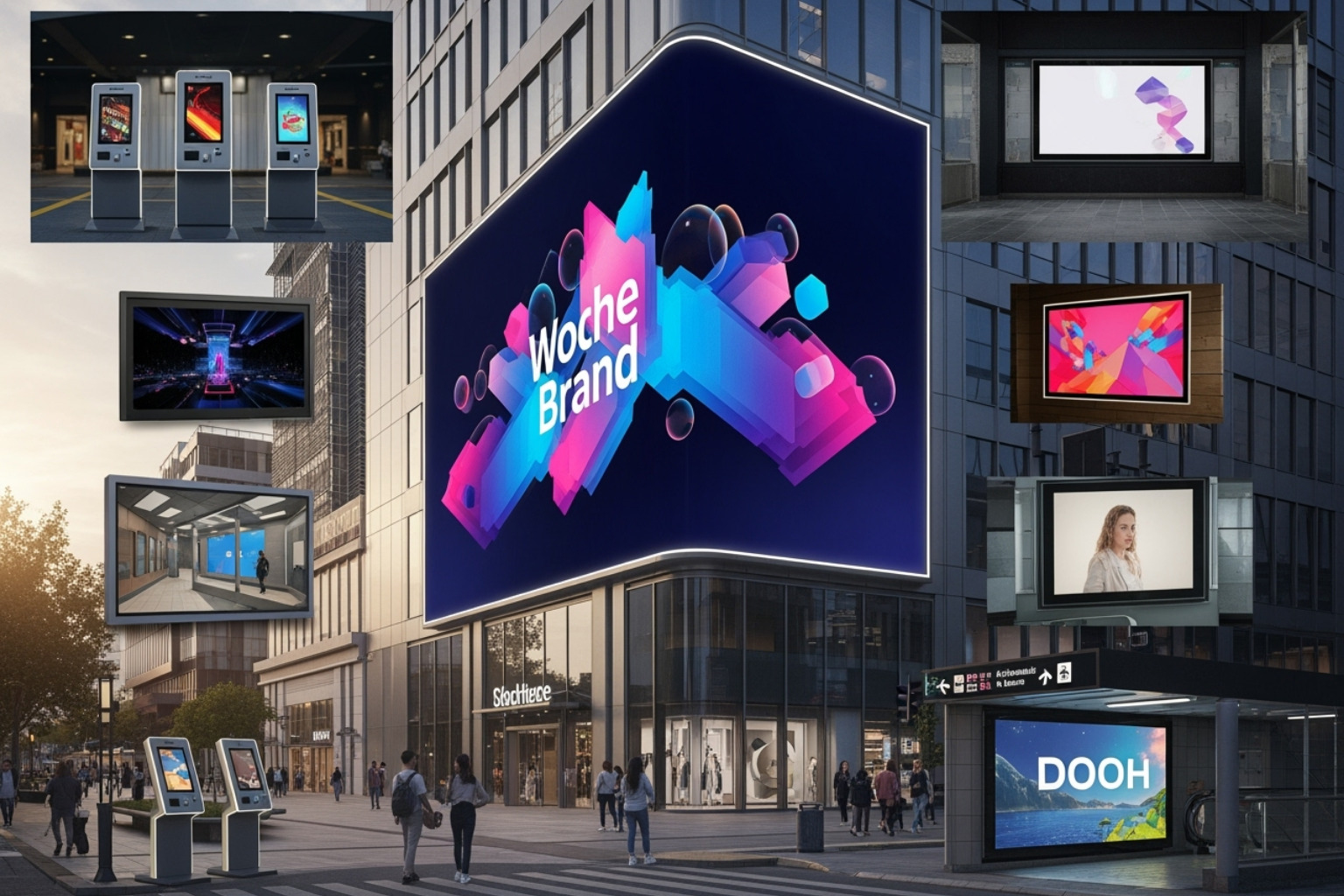What Are Digital Display Campaigns?
A digital display campaign uses visual ads—images, videos, and interactive content—to promote products or services on websites, apps, and social media. Unlike search ads, which target active searches, display ads reach potential customers as they browse, building brand awareness and driving traffic.
Key characteristics of digital display campaigns:
- Visual format: Combine images, text, videos, and interactive elements
- Wide reach: Appear on millions of websites through networks like Google Display Network
- Targeting options: Use demographics, interests, behaviors, and remarketing to reach specific audiences
- Multiple formats: Include banner ads, video ads, rich media, and native advertising
- Performance tracking: Provide measurable results through clicks, impressions, and conversions
Digital display campaigns place your ads on relevant third-party websites where your target audience spends time. When someone clicks your ad, they're directed to your website. With the average human attention span at just 8 seconds, compelling visual design and clear messaging are critical for success.
The banner advertising market is projected to reach an impressive $161.80 billion in 2023, showing the massive scale of display advertising. Companies using retargeting have seen significant boosts in brand-related searches and site traffic.
I'm Steve Pogson, founder of First Pier, a Shopify Expert Agency in Portland, Maine. With over two decades of experience, I've helped e-commerce brands grow by combining creative design with data-driven targeting to improve their digital display campaign performance and maximize ROI.

Digital display campaign helpful reading:
- what is a digital marketing campaign
- how to create a successful digital marketing campaign
- how to measure the effectiveness of a digital marketing campaign
Understanding the Core Components and Types of Display Ads
When a colorful ad catches your eye on a news website, that's a digital display campaign at work. Think of them as the internet's version of highway billboards, only much smarter and more targeted.

Display advertising offers a variety of formats. Banner ads are the classic rectangular graphics at the top, bottom, or sides of webpages. They can be static or animated and have been a staple since the first digital ad in 1994.
Interstitial ads are full-screen ads that appear at natural transition points, like between game levels. They are highly effective, with playable interstitials in games improving retention by 40%.
Rich media ads are interactive, including video, audio, or expandable formats that engage users more deeply. Video ads deliver short, memorable video clips.
Mobile ads are optimized for smartphones and tablets, often using features like GPS for location-based targeting. Responsive display ads are like chameleons; you provide assets like images and headlines, and AI systems automatically assemble them to fit available ad spaces.
Native ads blend in with the surrounding content, matching the look and feel of the website to feel less like advertising.
Behind most modern campaigns is programmatic advertising, an automated system that buys and sells ad space in real time, allowing advertisers to bid on showing ads to specific users.
The banner advertising market is projected to reach US$161.80 billion worldwide in 2023. For more details on Google's ad formats, check out more info about Google Display Ads.
Key Elements of a Successful Digital Display Campaign
A winning digital display campaign requires getting several key ingredients right.
Compelling visuals are the foundation. High-quality, eye-catching, and relevant images or videos are essential. Simple, clean designs often outperform cluttered ones.
Your clear headline needs to be concise and grab attention immediately. A strong call-to-action (CTA) tells your audience what to do next, like "Shop Now" or "Learn More."
Your brand logo builds recognition, and your value proposition should clearly communicate what makes your product unique. Consistency is key: your ad's messaging and visuals must align with your landing page to build trust.
Display Ads vs. Search Ads: What's the Difference?
It's crucial to understand the difference, as both play vital but distinct roles in a marketing strategy.
The main difference is user intent. Search ads are "pull" marketing—text-based ads on search results pages that appear when users actively search for something. The user has high intent.
Display ads are "push" marketing—visual ads across websites and apps that reach users who are browsing, not actively searching for your product. You're creating awareness or reminding them of your brand.
| Feature | Display Ads | Search Ads |
|---|---|---|
| User Intent | Low to medium intent (browsing, finding) | High intent (actively searching for something specific) |
| Format | Visual (images, videos, rich media, text) | Text-based (headlines, descriptions, extensions) |
| Placement | Websites, apps, social media platforms | Search Engine Results Pages (SERPs) |
| Goal | Brand awareness, consideration, retargeting, generating interest | Driving immediate conversions, direct response |
| Cost Model | Often CPM (cost per thousand impressions) or CPC (cost per click) | Predominantly CPC (cost per click) |
Understanding this distinction helps you plan a complete digital marketing strategy. The most effective approaches often combine both. To explore pay-per-click strategies, dig into PPC In Digital Marketing.
The Benefits and Common Challenges of Display Advertising
When I work with e-commerce clients on their digital display campaign strategies, we start with what to expect. Display advertising is powerful, but you need to know how to handle it.
Increased brand visibility is a major benefit. Your ads appear across millions of websites via networks like the Google Display Network, acting as digital billboards that keep your brand top-of-mind.
The targeting capabilities are very powerful. I can help you reach people based on their age, location, interests, and browsing behavior. For example, we can target parents in Portland who love outdoor activities.
Retargeting is where display advertising becomes truly effective. It reminds interested customers about your products. Studies show that retargeting can boost site traffic by 726% and increase brand-related searches by over 1,000%. Learn more in our guide on retargeting.
Display campaigns are highly measurable. Every impression, click, and conversion is tracked, so you always know how your investment is performing and can show a clear ROI.
Now, let's talk about the challenges, because planning for them is key.
Ad blockers are a major hurdle. About 40% of US internet users have them installed. We work around this by focusing on native ad formats and creating ads that offer genuine value.
Banner blindness is our brain's tendency to ignore standard banner ads. Creative design and relevant messaging are crucial to break through this mental filter.
Low click-through rates are common. Unlike with search ads, users are browsing, not actively shopping. Getting them to click requires more compelling creative and smarter targeting.
Avoiding intrusiveness is key. Pop-ups and auto-playing videos can create negative brand feelings. We focus on respectful advertising that adds value instead of interrupting the user.
Despite these challenges, display advertising is an invaluable part of a marketing strategy. It's about building brand awareness and creating multiple touchpoints with customers throughout their buying journey.
Setting Up Your Digital Display Campaign: A Step-by-Step Guide
Setting up a digital display campaign is manageable with a clear, step-by-step approach. Here's the process I use to help e-commerce businesses launch effective ads.
Platforms like Google Ads have streamlined this process, often using AI. You can learn more about effective Campaign Management In Digital Marketing.
Here’s how I approach setting up a campaign:

Step 1: Define Your Audience and Targeting Strategy
This is the most critical step. Before designing creatives, you must know who you're trying to reach to make the most of your budget.
I consider several targeting options:
- Demographics: Basic information like age, gender, and parental status.
- Interests (Affinity Audiences): Reach people based on their long-term interests, like fitness or tech.
- In-Market Audiences: Target users actively researching products or services similar to yours.
- Custom Audiences: Get specific by creating audiences based on keywords searched, websites visited, or apps used.
- Remarketing Lists: Target users who have already interacted with your website. They've shown interest, making them prime candidates for conversion.
- Placement Targeting: Choose specific websites or apps where you want your ads to appear.
Google Ads offers "optimized targeting," which lets its AI find high-performing audience segments. For more on this, check out our guide on Adwords Audience Targeting.
Step 2: Set Your Budget and Bidding Strategy
Next, decide how much to spend and how to bid for ad space.
- Daily Budget: The average amount you're comfortable spending per day.
- Bidding Strategies: This determines how you compete in the ad auction.
- Cost-per-Click (CPC): Pay each time someone clicks your ad. Best for driving traffic.
- Cost-per-Mille (CPM): Pay per thousand impressions. Used for brand awareness.
- Target CPA (Cost-per-Acquisition): Set a desired cost for a conversion, and the system optimizes bids to achieve it.
- Maximize Conversions/Conversion Value: Let the system automatically set bids to get the most conversions or value within your budget.
I recommend starting with a clear goal. For sales, use a conversion-focused strategy like Target CPA. For brand awareness, CPM might be better. Understanding these models is fundamental to Pay Per Click PPC advertising.
Step 3: Design Compelling Ad Creatives
Now, bring your message to life with your ad creative.
- Simple Design: With short attention spans, simplicity is key. Avoid clutter and focus on one clear message.
- Visual Hierarchy: Guide the viewer's eye by making important elements (product, headline, CTA) stand out.
- High-Quality Images/Video: This is essential. Blurry or unprofessional visuals will deter users. Invest in good photography or video.
- Clear CTA: Make your call-to-action prominent and easy to understand.
- Brand Consistency: Use your brand colors, fonts, and logo to build recognition and trust.
While responsive display ads handle most sizing, it's good to know top-performing formats like the 728x90 (leaderboard) and 300x250 (medium rectangle).
Here's a list of commonly effective ad sizes:
- Medium Rectangle: 300x250
- Leaderboard: 728x90
- Wide Skyscraper: 160x600
- Large Rectangle: 300x600
- Mobile Leaderboard: 320x50
For more details on ad sizes, see our guide on Google Display Ad Sizes.
Measuring and Improving Campaign Performance
Launching a digital display campaign is just the beginning. The real work is in the ongoing measurement and optimization, where you find out what's working and how to improve your return on investment.
Google Ads reports for Display campaigns can take up to 72 hours to appear. If you don't see results in the first 14 days, consider increasing your bid or updating your strategy to Maximize conversions.
Understanding campaign performance is about finding the story in your data and using those insights to make your budget work harder. For a deeper look at analytics, explore our guide on Digital Marketing Analytics.
Measuring the Success of Your Digital Display Campaign
To understand performance, you need to track Key Performance Indicators (KPIs).
I always watch Click-Through Rate (CTR), which measures clicks versus impressions. A higher CTR suggests your creative and targeting are effective. Display CTRs are typically lower than search ad CTRs, which is normal.
Conversion Rate shows how many people completed a desired action (like a purchase) after clicking. For e-commerce, this shows if your traffic is valuable.
Your Cost Per Acquisition (CPA) reveals how much it costs to get one conversion. The goal is to keep this number low while maintaining quality.
Return On Ad Spend (ROAS) is crucial for e-commerce, measuring the revenue generated for every dollar spent on ads. A 5:1 ROAS means you made $5 for every $1 spent.
Don't overlook Viewability, which tells you if your ad was actually seen. An ad is viewable if at least 50% of it is on screen for at least one second.
For brand awareness, Impressions and Reach are important. Impressions are total views, while reach is the number of unique viewers.
I use Google Analytics with ad platform reporting for a complete picture. Proper conversion tracking is essential. If you have a Shopify store, our guide on How To Setup Google Conversion Tracking Shopify can help.
Regular A/B testing of creatives is essential. I also monitor ad placement performance to exclude sites or apps that don't convert well.
How to Continuously Optimize for Better ROI
Optimization is an ongoing process of making small, smart adjustments based on data.
Refining audience targeting often yields the biggest wins. Double down on what works and pause underperforming segments. Google's "optimized targeting" can help find new high-performing audiences.
Testing different CTAs can have a dramatic impact. Try benefit-oriented CTAs ("Get 20% Off") versus urgency-driven ones ("Limited Time Offer").
Excluding poor-performing placements is necessary. If certain sites or apps generate clicks but no conversions, exclude them to avoid wasting your budget.
Pay attention to device targeting performance. Adjust bids or create device-specific ads if you see better performance on mobile versus desktop, or vice versa.
For responsive display ads, analyzing asset reports shows which combinations of images, headlines, and descriptions perform best. Use these insights to refine your assets.
Dynamic Creative Optimization (DCO) automatically tailors ad creatives in real time based on user data, showing the most relevant ad to each viewer.
Integrating first-party data from your CRM or Shopify store can help you create lookalike audiences or target existing customers with personalized messages.
By constantly monitoring and testing, you can significantly Increase ROI On Ecommerce Ad Spend and turn good campaigns into great ones.
Frequently Asked Questions about Digital Display Campaigns
Are display ads effective for small e-commerce businesses?
Yes, a digital display campaign can be very effective for small e-commerce businesses. You don't need a massive budget to start, making it highly accessible. What makes display ads attractive for smaller businesses is their cost-effectiveness for building brand awareness and driving targeted traffic.
Flexible targeting options mean you can start small, focusing on people who've visited your website or those in your local area. As you see what works, you can expand your reach. The measurable results are also a game-changer, as you'll know exactly how many people saw your ad, clicked it, and made a purchase.
I tell small business owners to think of display ads as a way to level the playing field. You can compete with bigger brands by being smarter with your targeting and creative.
How can I avoid "banner blindness"?
Banner blindness—the tendency for users to ignore ads—is a common challenge. The key is making your digital display campaign ads feel less like ads and more like valuable content. Engaging and high-quality visuals are your first line of defense.
Interactive elements, like a simple hover effect or a mini-quiz, can be very effective at breaking through the noise. A clear value proposition also works wonders. Instead of just showing your product, lead with the benefit.
Contextual placement is another powerful tool. When your ads appear on relevant websites, they feel natural rather than intrusive. Finally, regular creative refreshes prevent ad fatigue and keep your message feeling fresh.
What are the most important metrics to track?
The most important metrics depend on your goals, but there are some core KPIs every digital display campaign should monitor.
- Click-Through Rate (CTR) is your engagement barometer. It tells you if your ad creative and targeting are resonating with your audience.
- Conversion Rate is where the rubber meets the road for e-commerce. It shows how many clicks turn into sales or sign-ups.
- Cost Per Acquisition (CPA) is your efficiency measure. It shows how much you're spending to acquire each customer.
- Return On Ad Spend (ROAS) is often the most critical metric for e-commerce. It tells you the revenue generated for every dollar spent on ads.
While impressions and reach matter for brand awareness, focusing on these four metrics will give you the clearest picture of whether your campaign is moving the needle for your business.
To Sum Up: Making Display Ads Work for Your Brand
A well-executed digital display campaign is more than just images on a website; it's a strategic tool to boost brand visibility, drive quality traffic, and increase sales.
Success requires a blend of eye-catching creative design, precise audience targeting, and data-driven analysis to understand what's working. Every step matters: defining your audience ensures your message reaches people who care, setting a smart budget protects your investment, and designing compelling creatives gives people a reason to pay attention. When you measure and optimize, you turn good campaigns into great ones.
The digital world moves fast, but the core principles of connecting with people through engaging visuals and clear messages remain constant. Your customers want to know how you can help them, and display ads are one of the best ways to show them.
If you're an e-commerce business owner feeling overwhelmed by digital advertising, you're not alone. Many successful brands started in the same position, knowing they needed to grow but unsure how to make their digital display campaign efforts drive results.
That's where my team at First Pier comes in. We specialize in building high-performance online businesses and understand the unique challenges e-commerce brands face. We can help you develop and manage a marketing plan that makes sense for your goals and budget.
Ready to take your display advertising to the next level? You can get help with your marketing campaign strategy and start building campaigns that work for your business.








